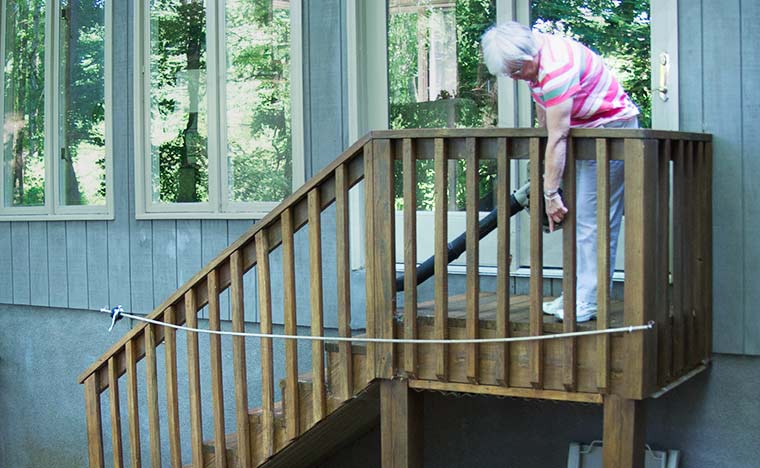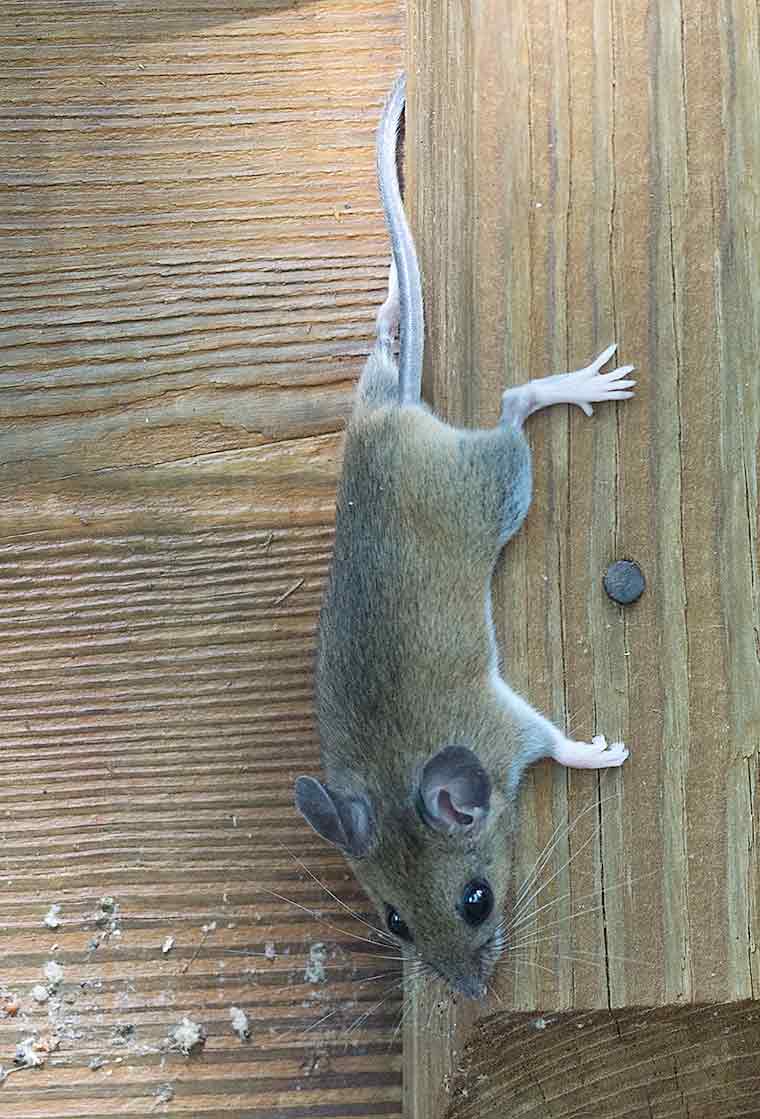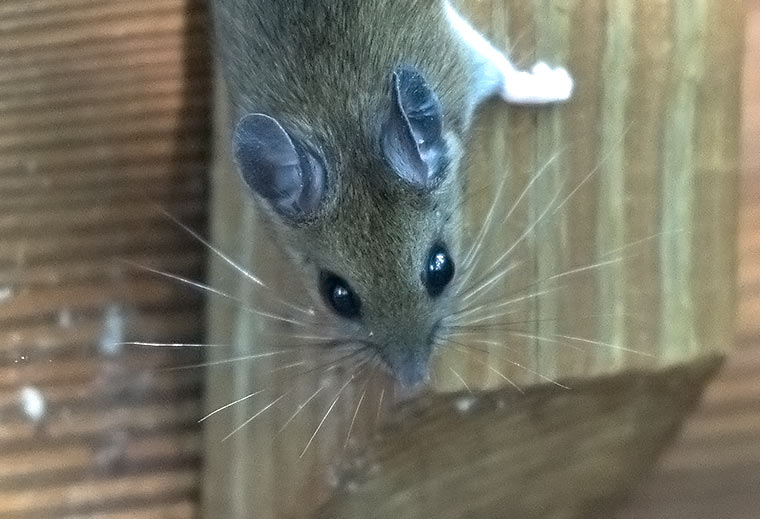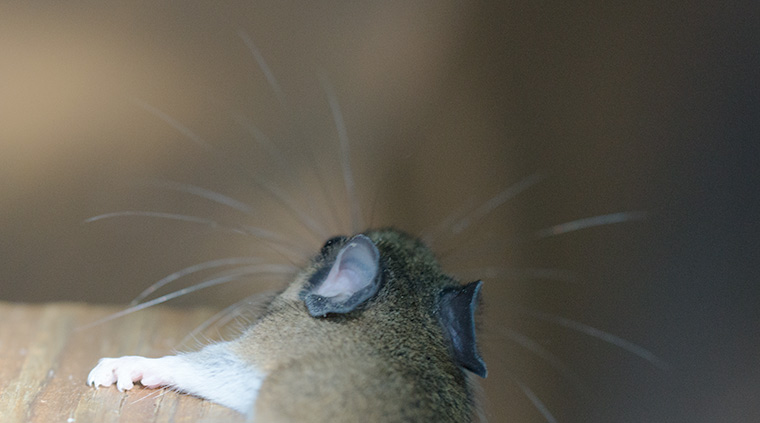I was working at my computer while Joyce was outside blowing the debris off the driveway and the back deck. I could hear the leaf blower running outside, but then I heard a loud rapping on the door that leads from the living room out onto the deck stairs. When I turned around, Joyce was trying to signal something to me with her free hand. I realized she was mimicking taking a photograph. So I grabbed a camera and hurried out onto the deck through a door leading from the garage.
 When I arrived she was alternately shouting something and pointing down from where she was standing. I could hardly hear her above the roar of the leaf blower, and I could not see anything to photograph in the direction she was pointing. I got a bit closer before I realized she was yelling “mouse”. I could not see any mouse, but I took several pictures blindly in the direction she was pointing. After a minute or so of her shouting and pointing, and me trying to find a mouse, I finally spotted it clinging to one of the deck posts. I took several photographs, and I was even able to hand the camera up to Joyce. She took some photographs before the mouse decided enough was enough and ran off into the woods.
When I arrived she was alternately shouting something and pointing down from where she was standing. I could hardly hear her above the roar of the leaf blower, and I could not see anything to photograph in the direction she was pointing. I got a bit closer before I realized she was yelling “mouse”. I could not see any mouse, but I took several pictures blindly in the direction she was pointing. After a minute or so of her shouting and pointing, and me trying to find a mouse, I finally spotted it clinging to one of the deck posts. I took several photographs, and I was even able to hand the camera up to Joyce. She took some photographs before the mouse decided enough was enough and ran off into the woods.
 I am not sure why the mouse decided to stop part way down the deck post in plain sight. I do know that predators are very attuned to movement, and they are less able to pick out motionless prey from the background. So the best defense may be to stay very still until the danger has passed. Joyce said she was going up the steps to blow off the landing when she saw it scurry over the edge. After she spotted it below her, she was afraid to turn off the leaf blower, because that might somehow cause the mouse to continue its escape.
I am not sure why the mouse decided to stop part way down the deck post in plain sight. I do know that predators are very attuned to movement, and they are less able to pick out motionless prey from the background. So the best defense may be to stay very still until the danger has passed. Joyce said she was going up the steps to blow off the landing when she saw it scurry over the edge. After she spotted it below her, she was afraid to turn off the leaf blower, because that might somehow cause the mouse to continue its escape.
This is a wild mouse, not a house mouse (Mus musculus). It is a member of a group called Deer Mice (genus Peromyscus). There are two species in our area that are very similar, the White-footed Mouse (P. leucopus) and the Cotton Mouse (P. gossypinus). They are difficult to tell apart, so take your pick! It certainly is a handsome creature.
 A closer view shows that our mouse is well-adapted for nocturnal activity. It has large ears and eyes plus an impressive array of whiskers.
A closer view shows that our mouse is well-adapted for nocturnal activity. It has large ears and eyes plus an impressive array of whiskers.
 Joyce’s photograph from above shows our mouse’s large ears and demonstrates the lateral extent of the whiskers. Such a spread of sensitive hairs would certain help navigation in the dark.
Joyce’s photograph from above shows our mouse’s large ears and demonstrates the lateral extent of the whiskers. Such a spread of sensitive hairs would certain help navigation in the dark.
In the western United States, Deer Mice have been shown to be carriers of hantaviruses, which cause very serious, potentially fatal diseases. In the Eastern U. S., Deer Mice are the reservoirs for the spirochete (Borrelia burgdorferi), which causes Lyme disease in humans. Deer Ticks (Ixodes scapulars) prefer to feed on deer, but acquire the Lyme disease spirochaete when they occasionally feed on Deer Mice. The infected tick can then transmit Lyme disease to humans. Deer ticks never acquire the Lyme disease agent from deer, they must acquire the spirochaete from an infected mouse. Deer Mice carry the Lyme disease spirochaete, but show no symptoms of disease.

Wow! What a cutie!!!
Unfortunately, Maggie thinks he/she is food with which she supplements her diet. Know any way to get her to stop hunting? A lot of cat owners say that their pets bring them mice, etc., into the house as a present. Maggie has the habit of bringing only parts! Disgusting!
Cats which roam outside, and especially feral cats, do take a heavy toll on songbirds and other wildlife, but I do not know any way to keep them from hunting if they are allowed to go outside. It is the nature of a cat to hunt, and man has not succeeded in “domesticating” that drive from their genetic makeup. I think the only way to keep them from hunting is to keep them indoors (where they will continue to hunt whatever they can find inside). Even a well-fed cat will hunt outside, although probably not as much as a feral cat, which has to hunt to feed itself. We don’t have a cat, but from talking to other cat owners, it appears that some individual cats are move avid or more skilled hunters than others. I also know little about different cat breeds either. Maybe some breeds would hunt less than others.
You know, Sam doesn’t hunt nor did any other cat we had. They were all male. Maggie is the first female we’ve had. Maybe that has something to do with it!
That is an interesting idea. I can think of a couple of instances in the (non-pet) animal kingdom where females might hunt more/better than males. I have read and seen in nature shows that in a wild African Lion pride, the females do most of the hunting, the males often wait until the kill is made then bully their way in for a share. In general, I think, any female wild cats would have to be good hunters, because they often have to kill enough to feed both themselves and their nursing or juvenile young.
Siidebar on African Lions: They are the only big cats that form large social groups. All the other big cats are together only briefly to court and mate. African Lion social groups (prides) are able to cooperatively bring down large prey, such as Cape Buffalo, adult Wildebeest (GNU), and other large creatures. The African plains have lots of prey too large for the small wild cats to bring down. Smaller cats are solitary and can bring down only smaller prey. The ability to hunt larger prey is often cited as the reason that African Lions evolved their social behavior. (However, it must be said that Leopards and Jaguars, which are solitary, can bring down some fairly large creatures. Leopards can bring down large creatures such as Wart Hogs, Impala,and humans. The Jaguar can bring down anything in its natural geographic range, however, there are no really large animals in its range. All big cats, social and otherwise, often eat the young of larger species, because they are often easier to catch, have few defenses, can’t run as fast, and maybe are better to eat. Most wild cats will also eat carrion, disease-weakened or killed animals, or a kill by another animal that the cats can drive away.
I fear these things like I do ticks
Interesting! Do you have general fear of mice or do you fear particularly Deer Mice because they are a reservoir species for Lyme disease?
i don’t like no mice, especially those that can kill me. in my view they are nasty disease carrying critters and the less i see of them the better.
EEEEEEEEEKKKKKKKK
Are you sure there should not one more E or K in your comment…